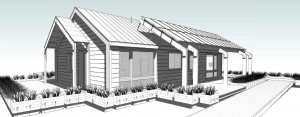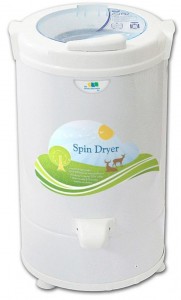The 2011 Solar Decathalon in Washington, DC was exciting and inspiring. Although focused on solar energy, the teams looked at the design problem holistically, creating solutions for: energy production and conservation, water consumption and conservation, hot water production, space utilization, regional appropriateness and marketability, that are simple, affordable and easily transferable to any home. I think that the fact that the teams were relatively unconstrained allowed them to be free with their design aspirations. The results were fresh faced and innovative solutions.
What did I take away as great design ideas?
- Underdeck rainwater harvesting storage tanks and bladders. Storage tanks can be enormous and even rain barrels can be cumbersome – if you have a deck with a little space below, why not stow a few 1,000 gallons of water under there to use on the lawn and in the garden?
- Building integrated solar thermal hot water systems for heat and hot water. Rather than adding panels over the roofing material, some teams integrated the solar thermal into the roof and/or into the architectural details of the homes. Solar thermal for hot water is very efficient but often doesn’t make great economic sense UNLESS it is part of a new design and integrated into the building or it also serves as the source of heating for the home.
- Sliding wall systems to allow flexibility in the use of space within the home. Several of the homes featured sliding walls that created intimate or wide open spaces depending upon the wall’s position. This was especially well done in the team from the Massachusetts College of Art and Design and the University of Massachusetts at Lowell.
 Their design had the luxury of a central structural spline that allowed all the center walls to move creating wide open great rooms or intimate living and bedroom areas. The walls served also as storage cabinets and sound attenuating devices. We could incorporate sliding doors and walls with great room spaces to create smaller, more manageable, people sized spaces.
Their design had the luxury of a central structural spline that allowed all the center walls to move creating wide open great rooms or intimate living and bedroom areas. The walls served also as storage cabinets and sound attenuating devices. We could incorporate sliding doors and walls with great room spaces to create smaller, more manageable, people sized spaces.
- On demand or tankless hot water or heat pump hot water systems. When replacing a hot water heater, both of these sustainable elements should be evaluated. If you have natural gas in your house already, a tankless hot water system may be the right course – it has the drawback of being fossil fuel fired but it does not store and heat water in anticipation of your next shower saving on electricity. If you have any issues with humidity, a heat pump hot water heater may be the right choice. These units are electricity dependent but are very efficient.
- Solar photovoltaics as architectural elements. The Massachusetts team used the panels as the entry canopy. The Maryland team used panels as part of their rainwater catchement system. Many of the teams used ‘bifacial’ solar panels as shading devices – these panels generate power from both sides driving up their efficiency by gathering energy from direct and ambient light. The University of Tennessee created window trellises that incorporate flexible solar panels rolled into tubes so that they shade the windows, become an architectural element and collect sunlight from any and every direction. By being creative, solar panels can be placed anywhere and can look great in the process.
- Single unit washer/dryers. If space is an issue, a single unit that washes and dries can come in very handy.
- Front load washers and dryers are very efficient from an electrical consumption and from a water useage standpoint.
- A spin dryer. I first used a centrifuge dryer at the YMCA to get the excess water out of the children’s bathing suits – it would get them nearly dry. This product is energy efficient and easy to use and cuts drying time significantly regardless if you hang your clothes on the line or run them through the dryer. Making the outdoor laundry line an integral design element makes it more likely that you will use it. Several teams placed them directly outside the kitchen door almost like a trellis to make them readily accessible and pretty.

- Low flow sinks and toilets were de rigueur.
- Home automation systems and lighting automation systems. Measuring and monitoring usage is the best way for all of us to manage our usage better. These systems are becoming available to the mainstream market and should be included in any new construction project and be evaluated for renovations.
- LED lighting. Lots of efficient and color correct LED lights were evident.
- Accessibility. Many of the homes were designed with aging-in-place in mind. Features included: ramps, roll in showers, accessible sink levels and wide hallways. When remodelling, elements like grab-bars and under cabinet space can be incorporated easily.
